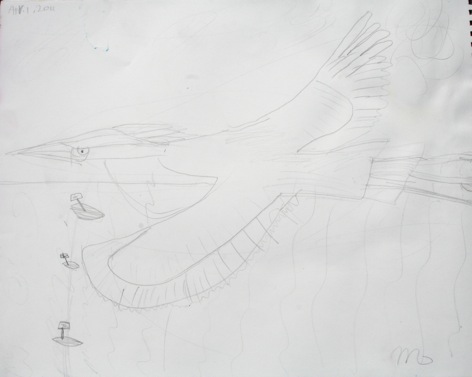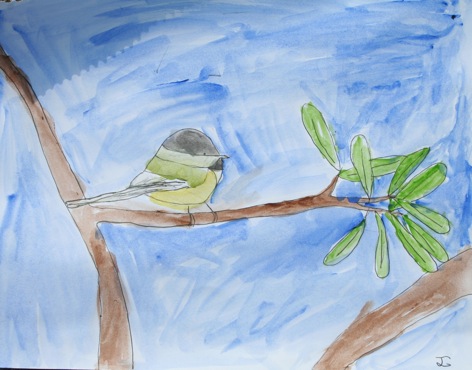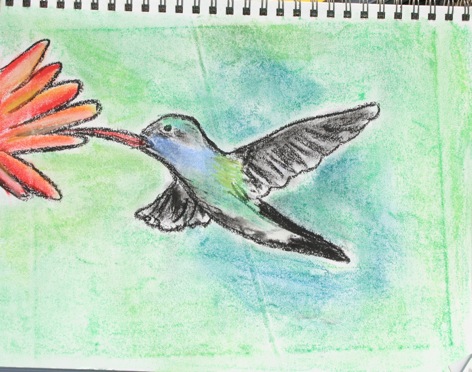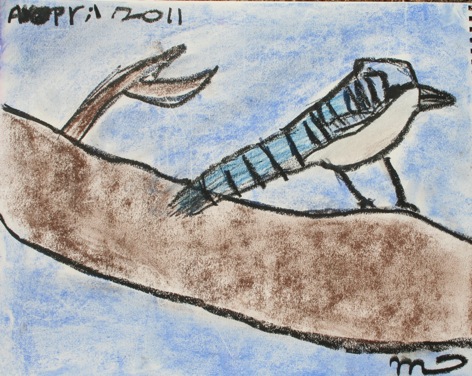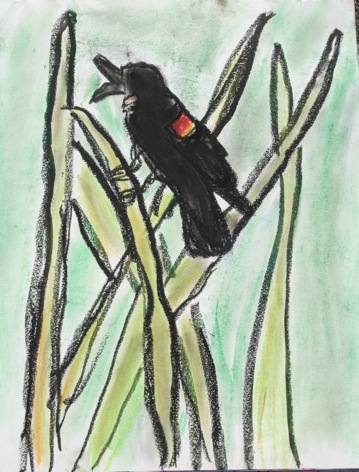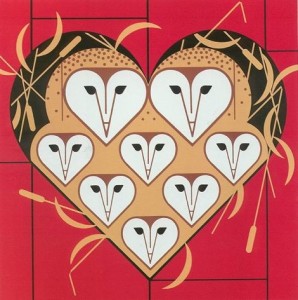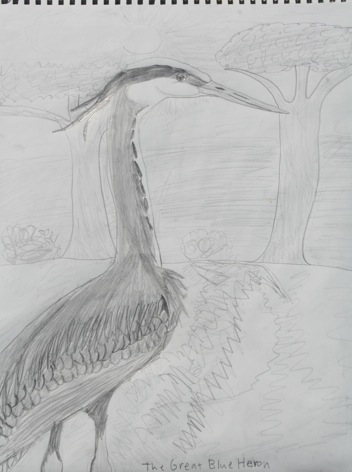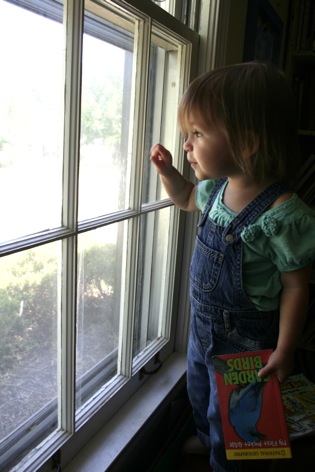Capture the Heart, and the Grammar Will Follow
We’re wrapping up our bird study this week with a final saturation. Â Today we took a couple of online quizzes to test our bird idenitification skills. Â With elbows and pats on the back we spotted bird after bird that would have been unrecognizable two months ago.The kids grab their bird books whenever we leave the house without any suggestive comment from me. Â We share a passion with Grandma now that can continue for years past our official learning time. Â Birding is no longer something I’m teaching them, they feel their own sense of ownership and kinship to these diverse, beautiful creatures.
On the other hand, I also looked through the girls individual assignments they’ve been working on to earn their bird nature patch at the local Nature Center. Â Allowing them to be independent, which is a little newer around here, I haven’t been checking over their work at each step.
Today I got the full picture and and I saw detailed information about bird species, habitat, anatomy, eating habits, and migration. Â I also saw partial sentences, lower case letters to start a sentence, sloppy handwriting, misspelled words, and mistakes crossed out instead of erased and re-written. Â The heart of the work was there, the presentation was lacking!
And whose fault is it? Â We haven’t spent much time on all things grammatical. Â It’s on my list for next year. Â Should I now berate myself and erase mentally what we’ve learned through our nature and art study in the recent months. Â The voice in my head begins, “If my child attended fill-in-the-blank school or lived with such-and-such-homeschool family, I’m sure they would get all of their skills at the same time with the same amount of excellence.”
I could run toward worry. Â I certainly have asked myself some questions today as I went over the necessary corrections with the girls(note: they are turning in this work for their badge, this isn’t work heading into the trash, which is why the focus on appearance presented itself).
Or I can breathe.
Wait, my breathing seemed a little too much like breathing during labor.
Let’s try again.
Do they have to learn all of their skills with equal ability in the 3rd and 4th grade?
Wouldn’t I rather have it this way than perfect punctuation without a bit of interest or passion?
I have a feeling if their hearts are captured with learning, the mechanics will follow easily enough when we’re ready.
Birdwatching Part 2: Art
After Christmas I had three ideas running about my head: poetry, art, and birds. Â We’ve enjoyed all three of them together this spring.
You can read more about our bird study and see our list of resources in this post.
Here are the artists we studied and the projects we explored.
John James Audubon
Books
- Audubon’s Birds of America–This is a wonderfully small book filled with Audubon’s Illustrations. It’s about 5×5 and I was lucky to find it at a used bookstore. Â Audubon’s Book of Birds was not originally published in America due to it’s size. Â He painted the birds life size and he wanted the book printed that way as well. Â I haven’t seen the full-sized book yet. Â Check with your library to see if they have a copy.
- The Boy Who Drew Birds by Jacqueline Davies–A beautifully illustrated picture book. Â A great introduction to the artist.
- A Nest For Celeste by Henry Cole: We follow the kind-hearted mouse, Celeste, as she befriends John James Audubon’s assistant. Â She has many adventures with the birds that are captured for Audubon’s drawings and in the surrounding fields. Â As wonderful as the characters are in this book, the black and white detailed sketches really bring the story to life. Â We kept our bird book on hand so that we could look up pictures of the birds as they entered the story. Â A great companion to study the of birds, mice, and/or John James Audubon’s art.
- On the Frontier with Mr. Audubon by Barbara Brenner-I just came across this book at the thrift store this week. Â It’s a fictional diary of Joseph, Audubon’s assistant(who is the same Joseph in A Nest For Celeste mentioned above), and it follows his journey with Audubon from Cincinatti down to New Orleans. Â We’ve enjoyed the chapters we’ve read so far.
- Audubon’s Birds of America Coloring Books(Dover)-This came with a science program we didn’t finish last year. Â I’m not a big coloring book fan so we didn’t use it a lot. Â Your family might really enjoy it though.
Art Projects
I didn’t plan Audubon specific projects, as far as imitating his exact style. Â But we did focus on realistic bird depiction first. Â So we did a lot of sketching from real birds and photographs of birds in our bird guide once the bird flew away.
Red-Bellied Woodpecker in Bird Sketchbook, 8 year old
Black Ink with Watercolor
- Collect some books from your own collection and the library with good-quality, close-up photography of birds.
- Choose a bird to sketch.
- First sketch your bird along with a part of his/her habitat in pencil.
- Trace all lines with a fine sharpie. Â A thicker sharpie will work as well if the details are not too small. We like to have both sizes on hand. (Make sure your pen is a permanent marker so that it does not bleed with the next step).
- Using watercolors, fill-in your picture. Â You can also use watercolor pencils and then smooth out the color with water and brush.
- Black ink outline and watercolor make for a quickly rewarding piece of art.
Black-Capped Chickadee, 8 year old
Goldfinches on Branch, 10 year old-Don’t you just love the repetition of color and pattern?
Oil Pastel Outline with Chalk Pastel Color
This project produces such vibrant colors! Â Chalk pastels can be messy but they work really well in this project so don’t skimp on them and only use oil. Â I went ahead and bought a pastel fixative to prevent further spreading of the chalk, I’ve read that you can use hair spray as well.
- Collect your books with great bird photography. Â You can also do a google image search and find photographs if you don’t have books on hand.
- Sketch the outline of your bird and habitat with a black oil pastel. Â That’s right skip the pencil. Â Go boldly with your pastel. Â (If your child is frustrated that she can’t erase and fix something in her outline, you can decide if she can switch to pencil. Â You might give her the chance first to transform her oops into something she likes.)
- Fill in your bird, habitat, and background with chalk pastels.
- Trace all lines again with the black oil pastel.
Hummingbird, Mama
Bluejay, 10 year old
Red-winged Blackbird, 8 year old
Charley Harper
I found this artist by accident while looking through the clearance at Barnes and Noble. Â I found a coloring calender and fell in love with his work. Â Like I mentioned, I’m not a coloring book fan, but I had to bring the calender home. Â Harper is a great contrast to Audubon. Â He calls his work minimal realism. “I don’t try to put everything in-I try to leave everything out. Wildlife art without the fuss and feathers.”
His titles include a play on words followed by a tongue and cheek description of the subject. “Beguiled By the Wild” includes an interview that I read aloud to the kids. Â He speaks of how he first learned to draw realistically down to the very hair and how everyone should learn to draw that way first before taking things out. Â A good principle to reinforce with the kids.
- Beguiled by the Wild: The Art of Charley Harper
- Charles Harper Birds and Words
- Charley Harper Coloring Calender-This is the calender I found on clearance. Â The kids colored some of them with colored pencils as they looked at the actual print in order to study his use of shapes and colors before we tried our own.
Charley Harper-Ish Art
Today we tried a Charley Harper Inspired Art Project-I decided to try collage with shapes in order to preserve the defined lines present in his work. Â I’d also like to try a printing project, I haven’t decided how yet.
- I cut out basic shapes(I flipped through his prints to see what shapes he used most often) from cardstock. Â Different sized circles, thin crescents, triangles, teardrops, and leaf shapes.
- I told the kids to pick their bird and the color of their background. Â Using acrylic paint we painted our background.
- Then they looked at photographs of their bird and decided what shapes they needed. Â (We didn’t look at Charley Harper’s version of their bird, I wanted them to decide on their shapes based the actual bird, just like Harper.)
- They used the pre-cut templates and traced them onto various papers.  I have a lot of scrapbook papers collected, you could use construction paper or cardstock. I encouraged them to cut a new shape if they needed it for their bird but  if it wasn’t already cut for them.
- They pasted their bird to the dry background. Â One child took a ruler and added lines to the wings in the style of Harper.
- Finally, if your child is old enough they can try their hand at creating a clever title and/or paragragh.
Barn Owl, 6 year old (He chose the shapes from the template, I helped him trace and cut them, he painted and glued)
“Sky Dive-Not from a plane and not with a parachute and especially not for fun. This falcon is diving for his lunch!”
Age 8
The King Who Fished with His Crown On, Age 10
(Kingfisher)
Part 3 of my Birdwatching posts will be on poetry.
Where Have We Been?-Birdwatching! (Part 1)
Where have we been these last few months? Taking a nice long break from blogs(mine and others) and…
We’ve been watching birds.
Birdwatching falls into the same category as History in my book. Â It’s filed right under Something I Never Thought I Would Care About EVER, But Now I LOVE it. Â This goes right back to my great secret about homeschooling, I have learned to love to learn.
In the same way we’ve become that family that watches historical documentaries for fun, we’re now the odd family trying to identify the birds that somehow made it into the rafters of Home Depot. Â We’re that family-all the way down to the two year old. Â We found her the other morning with the bird guides surrounding her, looking out the front window, identifying birds. True, she categorized all species as “Robin Bird”, but she does so with all the enthusiasm of a life-long birdwatcher.
I’m not a natural-naturalist. Â Homeschool friends think I am until I tell them the real story. Â Nature study doesn’t come easy for us, and it always looks so darn easy and beautiful on other peoples’ blogs. Â Early on I heard about keeping a nature journal and became quite frustrated when my 5 and 7 year old didn’t become Audubon immediately. Was I failing? Â Until this season of birdwatching, I put nature study on the back shelf.
Now I take a view with a longer lens. Â We’ve grown into History. Â We’re having a great, very natural time, studying birds. Â It’s exciting to think what we’ll be doing by the time the youngest is ten or twelve. Maybe science will be in the same category by then! Â So if you read this blog, and think “Oh my goodness, we have to study birds!”, and it doesn’t work for you-then put on the long lens, and keep doing what you’re doing for now. Â There’s time.
This has been a great multi-age study. Â We’ve read our bird books together, taking our nature walks together with baby on the back, and painted and water-colored our birds sitting around the table(okay, sometimes the baby is in bed for a nap by then).
We used to think we had two birds in our backyard: cardinals and robins. Â Now we know we have brown creepers, mockingbirds, starlings, grackles, chickadees, sparrows, and bluejays. Â We never noticed the constant chorus outside, now we notice it all the time. Â We thought all nests were in a tree and all birds ate seeds. Â Boy, did we have a lot to learn!
Our study of birds has included:
- Reading fiction and non-fiction books in the morning after breakfast.
- Working on activities from the nature patch program at our local nature center.
- Going on nature walks with our birds guides and identifying birds. Â (On our most exciting walk we found 9 different bird species, including the Pileated Woodpecker. Â Who knew woodpeckers could be 18 inches long?)
- Identifying birds around our backyard.
- Creating bird related art and poetry.
- Studying artists who have used birds as their subject.
Other than reading bird books every morning, I didn’t have a set schedule-we’ve tried to do related activities 1-2 times  a week.
Here’s are some resources that have transformed birds from black and white into brilliant color:
Activities
- Our local nature center is focused on Birds this season for their yearly Jr. Naturalist Program and they have put together a wonderful pamphlet of bird-related activities that can be done at home or during nature walks. Â Even if you don’t live in Tennessee, this would be a good jumping off point for studying birds together. Â It’s also provided individual work for my 8 and 10 year old as I say, “Go pick another nature patch project and get started.” Â You can print the pamphlet here.
Read-Alouds:
Chapter Books
- A Nest For Celeste by Henry Cole: We follow the kind-hearted mouse, Celeste, as she befriends John James Audubon’s assistant. Â She has many adventures with the birds that are captured for Audubon’s drawings and in the surrounding fields. Â As wonderful as the characters are in this book, the black and white detailed sketches really bring the story to life. Â We kept our bird book on hand so that we could look up pictures of the birds as they entered the story. Â A great companion to study of birds, mice, and/or John James Audubon’s art.
- Burgess Book of Birds by Thornton Burgess-Follow Peter Rabbit as he greets his many bird friends who live near the great orchard, and get to know the cheeky Jenny Wren who always knows the real scoop on everyone. Â Told in story form, we still learned a lot about the behavior and nesting of each bird. Â Take this book a chapter at a time. And keep the bird guide nearby to look at actual photographs.(The edition in the amazon link has photograph illustrations, ours has black and white sketches).
- Owls in the Family by Farley Mowat-I have not read this book, I found it at a used sale, perused it, and the kids have enjoyed it.
Picture Books
- The True Story of Stellina Matteo Pericoli
- Albert by Donna Jo Napoli
- Owl Babies by Marin Waddell
- Owl Moon by Jane Yolen
- Hawk Hill by Suzie Gilbert
Bird Guides
- The Young Birder’s Guide to Birds of Eastern North America(Peterson Field Guide)-Our favorite guide. A great guide for young, new birdwatchers. Â Using photographs instead of artist renderings, it’s easier to match the bird in nature to the bird in the book. Â At a quick glance you can read a physical description and description of the bird call, see what area in North America the bird lives(in all seasons), and it includes photos of both the male and female.
- Tennessee Birds-An introduction to Familiar Species(Pocket Naturalist)-Available for many states, this is a folded guide, good for a quick glance to identify the species and then look it up in a more detailed bird guide. Â This contains pictures and names, with colored illustrations, but no detailed information.
- Beginning Birdwatcher’s Book with 48 stickers(Dover)-I recently purchased this book for our 6 year old since he’s not as adept at sketching birds quickly during a hike. Â As the young birder sees a bird in nature, they find the sticker that matches and place it on the right page. Â Under the box for the sticker is information on food, nesting, range, and eggs, and a place for observations. Â Since buying this book, we’ve only had a chance to use it once. It has a very nice layout. Â I expected, however, a smaller book, easier for placing in a backpack, but this is closer to 12×10. Â I’m also not sure if I like the sticker vs. the sketching format, we’ll have to play with it some more.
- Birds, Nests, And Eggs-A Take Along Guide by Mel Boring: Includes helpful renderings of each bird’s nest and their eggs. Â Also several bird related activities.
Non-fiction Books About Birds
(Note: I just went to the library and grabbed the most interesting books each week. Â These are all great, but you can find other greats just by visiting your library shelf, if these are unavailable.)
- Birds in Your Backyard by Barbara Herkert
- On the Wing: American Birds in Migration by Carol Lerner
- Cradles in the Trees The Story of Birds Nests by Patricia Brennan Demuth
- A Place for Birds by Melissa Stewart
- Birds Build Nests by Yvonne Winer
- Urban Roosts: Where Birds Roost in the City by Barbara Bash
- Perching Birds of North America by Sarah Swan Miller
- Watching Water Birds by Jim Arnosky
- The Robin Makes a Laughing Sound: A Birder’s Journal by Sallie Wolf
- Gone Again Ptarmigan by Jonathon London
- Feathers by  Dorothy Hinshaw Patent
- Owls Whooo are they? by Kila Jarvis and Denver W Holt
Videos about Bird Identification/and other great information about birds
- Cornell School of Ornithology–We have really enjoyed the four videos on this side about bird identification. Â I recommend loading the videos while you’re busy doing something else and then coming back to watch it.
- Planet Earth: Â Don’t miss this breath-taking series. Â Though not specifically about birds, there are bird species throughout. Â Although the narrator includes some evolutionary commentary, we simply spoke to our kids about it first. Without intending to, the producers created a series that brings glory to God and all of His creation!
- March of the Penguins
After you’ve studied birds for a little while, test your knowledge with these two online quizzes.
In the next post I’ll share more about the artists we studied and a few art project and poetry ideas.

